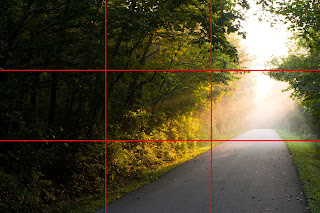Digital Images
Rule Of Thirds: Imagine that your image is divided into 9 equal segments by 2 vertical and 2 horizontal lines. The rule of thirds says that you should position the most important elements in your scene along these lines, or at the points where they intersect. Doing so will add balance and interest to your photo. Some cameras even offer an option to superimpose a rule of thirds grid over the LCD screen, making it even easier to use.
https://commons.wikimedia.org/wiki/File:Rule_of_thirds_photo.jpgLeading Lines: When we look at a photo our eye is naturally drawn along lines. By thinking about how you place these leading lines in your composition, you can affect the way we view the image, pulling us into the picture, towards the subject, or on a journey "through" the scene.
https://pixabay.com/en/railway-leading-lines-road-1666919/
Framing: The world is full of objects which make perfect natural frames, such as trees, archways and holes. By placing these around the edge of the composition you help to isolate the main subject from the outside world. The result is a more focused image which draws your eye naturally to the main point of interest.
https://pixabay.com/en/photos/frame/
https://pixabay.com/en/photos/frame/
Cropping: Often a photo will lack impact because the main subject is so small it becomes lost among the clutter of its surroundings. By cropping tight around the subject you eliminate the background "noise", ensuring the subject gets the viewer's undivided attention.
https://www.flickr.com/photos/usdagov/30435250875
https://www.flickr.com/photos/usdagov/30435250875
Definition:





Comments
Post a Comment